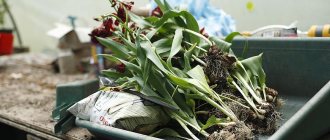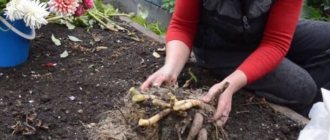The main school flowers, gladioli, have bloomed, and now we have to dig up the corms and properly preserve them until a new planting. It seems that there is nothing complicated here, but the simple rules of gladioli agricultural technology are difficult to apply to specific climatic conditions. You have to retreat from them, and this may ultimately affect flowering next year. In this article we will tell you what members of our portal do with gladioli in September.
And on our portal you can read an article about how to make a school bouquet of gladioli and other country flowers.
When to dig up gladioli
According to agricultural technology, gladioli are dug out 35, and for late varieties - 40-50 days after the end of flowering. In reality, this is not always possible: flowering may end with the onset of stable frosts, and if you wait a month and a half, you will have to dig the corms out of the snow. Therefore, agronomists advise not to be afraid and to harvest gladioli earlier - if you provide them with good storage conditions, overwintering will go well.
It is also recommended not to delay harvesting because in cold and damp soil the corms begin to rot and become sick. This, first of all, concerns varieties with early flowering and dark-colored gladioli, which are characterized by low immunity to fungal diseases. They are the ones that are removed first. The gladioli that we grew from children can be removed later.
All gladioli are dug up before the onset of stable frosts.
The ideal day for digging is dry and warm; the soil should not be wet, but it should not be dry to a stone state, otherwise there is a risk of losing a large number of babies.
Features of the plant and indications for digging up bulbs
When deciding whether to remove the bulbs from the ground for the winter, it is worth starting from the prevailing climatic conditions. In particular, in the southern regions in the cold months the temperature remains mostly at zero; digging up gladioli in the fall is not relevant here. During the period of frost, it is advisable to cover the plantings with a protective material, for example, agrospan or film.
In the middle and northern latitudes, harsh and long winters are expected; the autumn preparation of gladioli, in addition to digging, consists of protecting them from disease and freezing. It must be remembered that in the north the plant is planted quite late, in some cases the bulbs do not reach maturity. The harvesting period for fennel in mid-latitudes is the end of September; frosts begin by these days.
When to dig up diseased gladioli
The leaves of gladioli are often affected by spots, especially if the summer was rainy and not very warm. This indicates that the plant is suffering from a fungal disease and looks like this:
If the lesion is quite large-scale, and not two or three spots on the entire plant, it makes sense to dig up the corms earlier than usual so that they, too, are not affected by the disease.
Features of germination in the Urals, Siberia, and Moscow region
The soil warms up differently in different regions of the country. The preparation of bulbs for planting in the spring begins at the following times:
- Moscow regions and Moscow region - in early April.
- St. Petersburg – beginning – mid-June.
- Central Russia - the second ten days of May.
- Non-Black Earth region - the first days of April.
- Southern cities and regions - mid-March or mid-April.
- Western, Eastern Siberia and the Urals - mid-April.
With such preparation times, gladioli will bloom in early September. Adjustments to the preparatory work can be carried out in the event of a late onset of winter or, conversely, during warming.
Gladioli need careful preparation for planting in the spring . This must be done within the time limits established for a specific region. Only whole bulbs without visible signs of disease and without external defects are allowed for planting. If you follow all the rules for preparing, processing and storing gladioli, the flowers will delight you with bright blooms already in September.
How to dig up gladioli
The stems of gladioli can be mowed before digging, or trimmed after digging. The corm is trimmed with pruning shears so that nothing unnecessary remains; both the roots and the entire above-ground part are cut off (but you can leave a stump up to 1 cm in size).
Trimmed corms are placed in a foundation solution (0.1%) for half an hour, then washed and placed in a solution of potassium permanganate (0.3%) for another half an hour. This, of course, is an ideal processing option, but in extreme cases you can be content with the minimum.
GALE Member of FORUMHOUSE
It is imperative to treat with at least a dark cherry solution of potassium permanganate (30 min.).
Can it be planted in pots?
Without preliminary germination, gladioli can be prepared for winter planting in simple flower pots. To do this, perform the following steps:
- 0.2–0.5 cm of drainage is placed at the bottom of the container;
- the remaining space is filled with freshly prepared soil;
- gladioli are buried in the ground up to the root collar;
- Lightly spray the soil surface with warm water.
When it gets warm, flowers in pots are taken out into the fresh air to harden.
How to cull corms
Below in the photo we see a fully matured corm.
Signs of maturity of the gladiolus corm:
- Full-blooded root scales; the baby is “dressed” in scales.
- The scales of the baby are dense and dark.
- The baby is easily, without effort, separated from the corm.
During the growing season, one peduncle grows from the corm, and one young (replacement) corm with children is formed. Beginners often worry that they won't be able to figure out where the babies are and how to get them off.
Mariska Member of FORUMHOUSE
The children are impossible not to notice. Association: a large river mother mussel with a bunch of baby mussels clinging to the shell.
It happens that not one bud awakens in the corm, but two or three. In this case, two or three peduncles will grow and two or three replacement corms will form. In the spring, inspect each corm again, and if you notice that there is not one sprout, but two or three, leave the strongest one and break off the rest.
On average, corms of one gladiolus replacing each other live 3-4 years; Every year the corm becomes flatter, and its productivity and immunity decrease. It is because of this that old bulbs are discarded and burned, but unscrupulous sellers willingly slip them to newcomers. Unfortunately, it will not be possible to obtain a good, flowering plant from such a corm. When buying, look carefully, here are the signs of an old onion:
- it is flat;
- she has a wide bottom.
Otherwise, there may be such a sad picture - it looks like there is a flowerbed full of gladioli, but you still won’t get any flowers.
Valucha Member of FORUMHOUSE
This year I have a problem with gladioli - none of them bloom fully, all the buds turn yellow and wither.
We also do not take into storage children whose shells have burst or their corms are damaged.
Useful tips
To grow beautiful and lush gladioli, gardeners need to adhere to the following tips:
- For germination, planting material with a diameter of 3-4 cm is ideal. The bottom of the bulbs should be 4-7 mm. It is better not to use tubers that are too soft, dry or darkened. They are difficult to prepare for planting; they may not germinate.
- It is important to remove all the dry scales that cover the bulb. They interfere with the germination of young shoots.
- It is necessary to carefully select the variety of gladioli. It is better to purchase flowers based on the region of residence, focusing on the local climate. Heat-loving varieties will not grow in colder climates.
- To obtain abundant and lush flowering when storing bulbs, you need to adhere to the correct temperature regime - 5-10 degrees Celsius. Do not overheat the planting material or expose it to hypothermia.
- During the flowering of gladioli, you need to trim off the wilted buds. Such manipulations will prolong the flowering time of the rest.
How to prepare gladioli corms for storage
Treated gladioli are placed on a dry, clean litter and dried for 10-15 days at a temperature of +25 - +30 degrees in the open air or indoors with good ventilation.
GALE
I keep it at the top of the kitchen cabinet near the hood.
After this, we carefully separate the replacement, young corm from the old one and the remnants of the roots. If we have properly cared for our gladioli, the bulb will be wrinkled, small, almost hidden in the roots. We separate the children. Many people do not like to tinker with them, however, it is better to spend time on them if you want to preserve the variety for a long time.
Sveta2609 Member of FORUMHOUSE
It's not difficult to collect children. I choose the largest ones, the size of a pea, and store them in a nylon stocking in the refrigerator. If you save only large bulbs, then after 3-4 years you can lose half of the varieties, because Gladioli bulbs degenerate over time. And the large children will begin to bloom in a year.
We send the young corms for further drying for another three weeks to a month at +18-+22 degrees. Children dry in less time; they cannot be allowed to dry out. And corms need a minimum amount of moisture for successful storage.
Is it possible to use gladioli for forcing: plant them in the fall so that they bloom in the spring?
Gladioli can be used for forcing, but this requires a lot of effort. For the full development of gladiolus in winter, you will have to provide the plants with additional lighting with fluorescent lamps for at least 6-8 hours a day, monitor the level of humidity and ventilation. In conditions of lack of light, the gladiolus will not bloom, and the dry, stagnant air from winter heating will weaken the peduncle - it will be fragile (it will most likely break or fall over) and/or crooked.
For forcing, healthy corms with a diameter of 4-6 cm are selected. From the beginning of November, corms are stored for 45 days at a temperature of +16...+18°C. Over the next month and a half, the temperature is raised to +20°C and the corms are stored at high humidity in a bright room. After this period, the corms are planted in boxes with prepared soil to a depth of at least 30-40 cm. For 45 days after planting, the soil temperature is maintained at +12°C, the air temperature is +12...+14°C, then the soil temperature is raised to +15°С, and air up to +20°С.
You can learn more about forcing bulbous plants from this article >>>>>>
Specialists of the Moscow Club of Gladiolus Growers believe that the varieties Plum Tart, Ulybka Gagarina, Wine and Rose, Oscar, Blue Knight, and Moldova are suitable for forcing.
How to store gladioli in winter
During the entire drying time, we monitor the corms and if we see that some are starting to deteriorate, we throw them away. After drying, we place the corms in paper bags (or thin stockings, very convenient!) and send them for storage. Children are kept separately.
It is advisable to store babies in a paper bag. As a rule, all members of our portal store corms in a vegetable drawer in the refrigerator, in a box on the windowsill in a heated country house, or on a glassed-in loggia. The main thing is that the temperature is stable throughout the entire storage period and is +5-6 degrees. Proper storage can, among other things, prevent the development of a dangerous pest - thrips.
Krysya Member of FORUMHOUSE
Here's what I learned today about gladioli: they can be infested with thrips. These are small black or white, flea-like creatures that chew out the flower stalk.
These bulbs are infested with thrips.
These bulbs are infested with thrips.
To get rid of thrips, you need to treat the corms with mothballs. Or do it simpler: add a few heads of garlic to the wintering gladioli. Or here’s another newspaper-dichlorvos method:
Samaritan Woman Member of FORUMHOUSE
After drying and cleaning, I put the bulbs in a plastic bag, along with crumpled newspaper sprinkled with dichlorvos, and tie them up for two or three days. Removes thrips completely.
Tricks for protecting yourself from pests
Gladioli are vulnerable to pathogenic microorganisms and thrips. The latter penetrate under the husk and intensively feed on the sap of the plant, as a result of which the bulb dies. To protect seed material from pests, you can use garlic: it is placed in boxes intended for winter storage of flowers, in the form of chopped cloves. The bulbs need to be checked from time to time and dried garlic should be replaced with fresh garlic.
Paraffin - a means to protect against pests of gladioli
Paraffin wax may also be helpful. The candle is melted into a container, the latter is placed in a water bath so that the wax remains warm, but not scalding hot. All bulbs are dipped one at a time into the mixture and then into water, thus creating a shell that prevents moisture loss and the penetration of infection from the outside. In spring, the paraffin will be easy to remove by hand. It should be remembered that this measure will not save already infected copies.
The drug Zineb helps control pests. The tubers are kept in it for half an hour, then dried for at least 2-3 days, spread out in a frost-free, ventilated area, and then returned to their original storage location.
What to do if the corms wake up in the middle of winter
In winter, gladioli corms go through two phases. The first phase, the natural resting phase, lasts about 40 days. At this time, the corm will not sprout, even if it is warm and humid. Then comes a period of forced dormancy, and here it can already germinate. If this does happen, you will have to take out the corms, lay them out for a week to dry in a room with the heating on, and put them back in a cold place. When there are 2-3 weeks left before planting, the storage temperature will need to be increased to +15 degrees.
On FORUMHOUSE you can find any information on the agricultural technology of gladioli and information on the agricultural technology of other bulbous plants. Check out our gladiolus show: photographs of the most beautiful blooming gladioli grown by members of our portal. Read the article on how to store, root and divide dahlias. Watch our video about forcing, keeping and planting bulbs.
Should I germinate in advance?
In the northern regions, where summer is very short, you should start germinating the seed in advance. Preliminary preparation is not needed only when early varieties are purchased that bloom in the first half of summer or in the middle of the warm season.
Reference! 3 weeks before planting, the bulbs are laid out on a horizontal surface in one layer. During this time, white root tubercles should begin to form on the seed. The best option would be the appearance of strong shoots 3 cm high.











